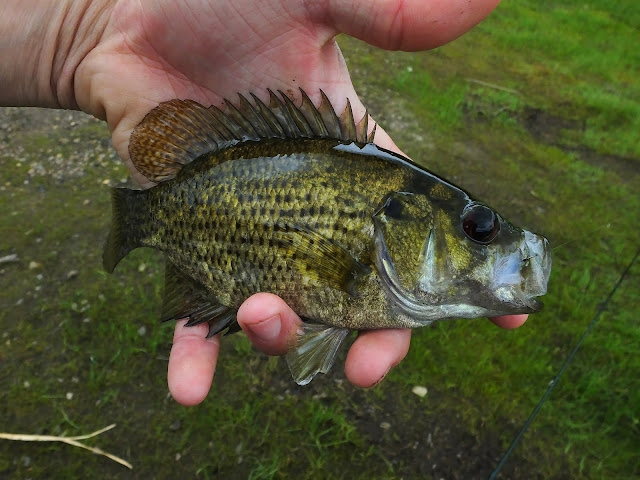... and smallmouth bass in the big river, the Housatonic. I rarely ever get to fish this area, so new species or not it was worth it, especially to just hammer on smallmouth constantly. Small though the bulk of them were they fought incredibly hard, which all smallmouth do, but compared to the smallmouth in my home waters... well, these ones had a lot more current to fight against to build muscle mass.
 |
| Micropterus dolomieu |
10 inch smallmouth are awfully easy to find though. But something that isn't easy to find in these part is a 26 inch brown sticking his big noggin up, somehow both recklessly and slowly eating a slurry of duns, spinners, and spent caddis. It was a classic scenario. the fish was within 4 feet of the bank, sitting right on the shelf, in a seem of current behind a boulder and submerged log. I saw him while scanning the tailout of the pool. He was exactly where such a fish should be, but I don't expect to see such a fish in CT and so wasn't looking for him. I was expecting to see some ripples and rings, made by the to-be-expected 14-18" Housatonic browns, and I didn't see any. But out of the corner of my eye I saw this monster's prehistoric looking head cut through the film, mouth open, close on a march brown dun, then slide back down, making almost no discernible disturbance to the water's surface. The fish's mouth alone looked about 6 inches long. I'm not going to lie, this fish scared me a little. It has been a couple years since I've seen a head like that sucking down a floating insect, and I was not at all mentally prepared to deal with the situation. I sat back and watched, trying to gather as much information as I could before making an approach. I re-tapered my leader to fish a dry. The cast and presentation were going to be easy enough. I could see that the fish was eating virtually every bug that cam through his slot, and was making about a 10ft loop of the spot, primarily rising on his way back upstream and primarily taking things to his left. I tied on a size 18 spent caddis. When a trout is clearly taking a broad mix of insects on the surface, I will always opt to present it a caddis, even if there are more mayflies on the water than caddis. I pulled out my camera and tried to get some decent shots of his big noggin. I never got a really good rise out of him when I had the camera on, just sips.





I had the space to make more than one presentation, and that's what I wanted to do. I wanted to slowly close in on the fish, rather than drop it right in his lane, because he was moving a long way and I knew if I got him to move two feet to his left he'd be all the more likely to take. In practice, this was great, but I hadn't taken into account that it would guarantee a complex rise (as described in Gary Borger's "Presentation"). I've not needed to set a size 18 hook on a 26 inch wild brown facing straight downstream, well, ever. And I blew it. The take was so perfect. The fish didn't hesitate at all. It was glorious, seeing that mouth close. And I did wait, just not long enough. I didn't give the fish time to turn. I felt nothing. And for a bit, I didn't think the fish possibly could have sensed any foul play. There was no harsh reaction at all. I fully expected to see it come back up.
It never did. We even left and came back for the evening rise. That fish never showed itself again. I even sent Mark Phillipe the spot yesterday so he might catch it for me, and he sent me photos of a great fish, but it wasn't the one I saw. I have to wonder how long that fish has been in the river and how much experience it has had with angling pressure. It may well have picked up shop and moved some serious distance after it knew someone was after it. I have a feeling I missed a very rare opportunity. The river spoon-fed me an excellent shot at a very large, smart fish, and I screwed the pooch. So... yeah. The image of that fish is burned into my brain forever. It was every bit the size of my largest dry fly brown.
Time to drown my sorrows in smallmouth bass and giant fallfish. If smallmouth every other cast and 16 inch fallfish don't make you smile, what's the point anymore?
 |
| Semotilus corporalis |
Add a creek chub to my species total for the day was 14. That was pretty good. But in 14, not one new one. And no monster dry fly eating browns. There is always room to improve. Always.
If you enjoy what I'm doing here, please share and comment. It is increasingly difficult to maintain this blog under dwindling readership. What best keeps me going so is knowing that I am engaging people and getting them interested in different aspects of fly fishing, the natural world, and art. Follow, like on Facebook, share wherever, comment wherever. Also, consider supporting me on Patreon (link at the top of the bar to the right of your screen, on web version). Every little bit is appreciated! Thank you to my Patrons; Erin, David, john, and Christopher, for supporting this blog.




























Dang, 14 species in a day and an encounter with a beast... Plus some really nice river smallies - that, is a GREAT day on the water!
ReplyDelete14 up here only in freshwater is half decent. But I find it lackluster having fished in FL a few times now.
Delete